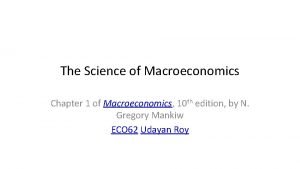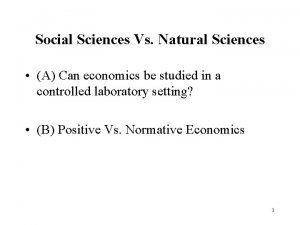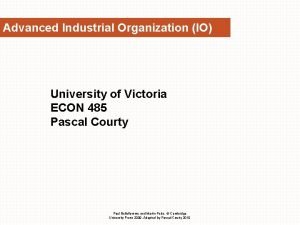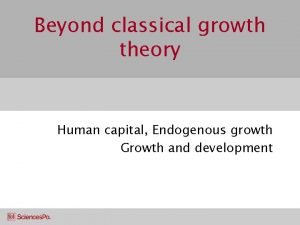Introduction to Endogenous Growth The economics of ideas










- Slides: 10

Introduction to Endogenous Growth The economics of ideas Econ 4960: Economic Growth

Review of the Exogenous (Solow) Growth Model Investment cannot be the source of long-run growth Only TFP growth generates sustained growth Where does TFP growth come from? We don’t know Endogenous growth models seek to explain the behavior of TFP growth. These are called “endogenous-”, exactly because TFP is determined within the model. . That is, “endogenously. ” Econ 4960: Economic Growth

Road Map for Coming Lectures Economics of Ideas (CJ, Chapter 4) Basic Endogenous Growth: The AK Model (Romer 1986, Lucas 1988) CJ, Chapter 9 The Full Model in Romer 1990 Econ 4960: Economic Growth

The Economics of Ideas improve the technology of production: Ford paid double the market wages and got much higher labor productivity. Schwab made workers in different shifts compete to improve output per worker. Japanese companies, Wal-mart and others developed and improved Just-in-Time (JIT) Production and Inventory management techniques Amazon, Apple, Google, Facebook, etc. Econ 4960: Economic Growth

Key feature of Ideas are very different than most economic goods. They are non-rivalrous: One person using an idea does not preclude others from using it. Ideas are not the only non-rivalrous good: national defense, satellite TV, digital music, etc. The key feature of all non-rival goods is that: (i) very high fixed cost and (ii) ~zero marginal cost of production Non-rival goods are often called “intellectual property” Paul Romer was one of the first to appreciate the importance of the non-rival feature of ideas for growth. Econ 4960: Economic Growth

Excludability Another attribute of goods is determined by their “excludability. ” For example, ideas are “excludable” to a certain degree: If you have a patent on an idea, societies can enact laws to punish those who use the idea without permission. Aside: many major companies earn enormous amounts from their patents. Other non-rival goods can also be excludable: If you hold the copyright to the Beatles collection (like Michael Jackson did) then the law will punish those who copy music. Some rival goods may be difficult to exclude from (Tragedy of commons): Trees in a forest, fish in international seas, etc. Econ 4960: Economic Growth

Econ 4960: Economic Growth

(1) Non-rival goods, (2) increasing returns, (3) imperfect competition Recall that non-rival goods have high fixed cost and very low marginal cost of production. Cost of first Airbus 380: About $12 billion. Cost of second one: $225 million. Cost of first copy of Windows Vista: 6 years and 6 billion dollars. Cost of second copy 5 cents. So as production expands, the average cost keeps falling, creating increasing returns. Of course price does not equal marginal cost in these markets (a copy of vista costs $299). Why? (1) The firm has to pay for the upfront fixed cost. (2) Moreover, innovation is a very risk business. Without a high enough price, innovators would not find it profitable to innovate. Econ 4960: Economic Growth


Tension between Innovation and Monopoly Power q These examples highlight a tension inherent in the economics of ideas: q q With perfect competition, you cannot exclude, i. e. , prevent others from stealing the idea, in which case there is no incentives to innovate. If laws are designed to protect innovators through patents and copyrights, this grants monopoly rights to firms, introducing monopoly distortions. q Some recent research suggests that the degree of protection awarded to innovators (and investors more broadly) under different legal systems may be one of the major reasons behind the different income levels of different countries. q We will begin with a simple AK model of growth then move on to richer models. Econ 4960: Economic Growth
 Neoclassical growth theory vs. endogenous growth theory
Neoclassical growth theory vs. endogenous growth theory Endogenous variables and exogenous variables
Endogenous variables and exogenous variables Exogenous variables examples
Exogenous variables examples Endogenous covariates
Endogenous covariates Endogenous variables
Endogenous variables Chapter 58 coronal polishing
Chapter 58 coronal polishing Advanced industrial economics
Advanced industrial economics Endogenous attention
Endogenous attention School of business and economics maastricht
School of business and economics maastricht Non mathematical economics
Non mathematical economics What is growth analysis
What is growth analysis


















